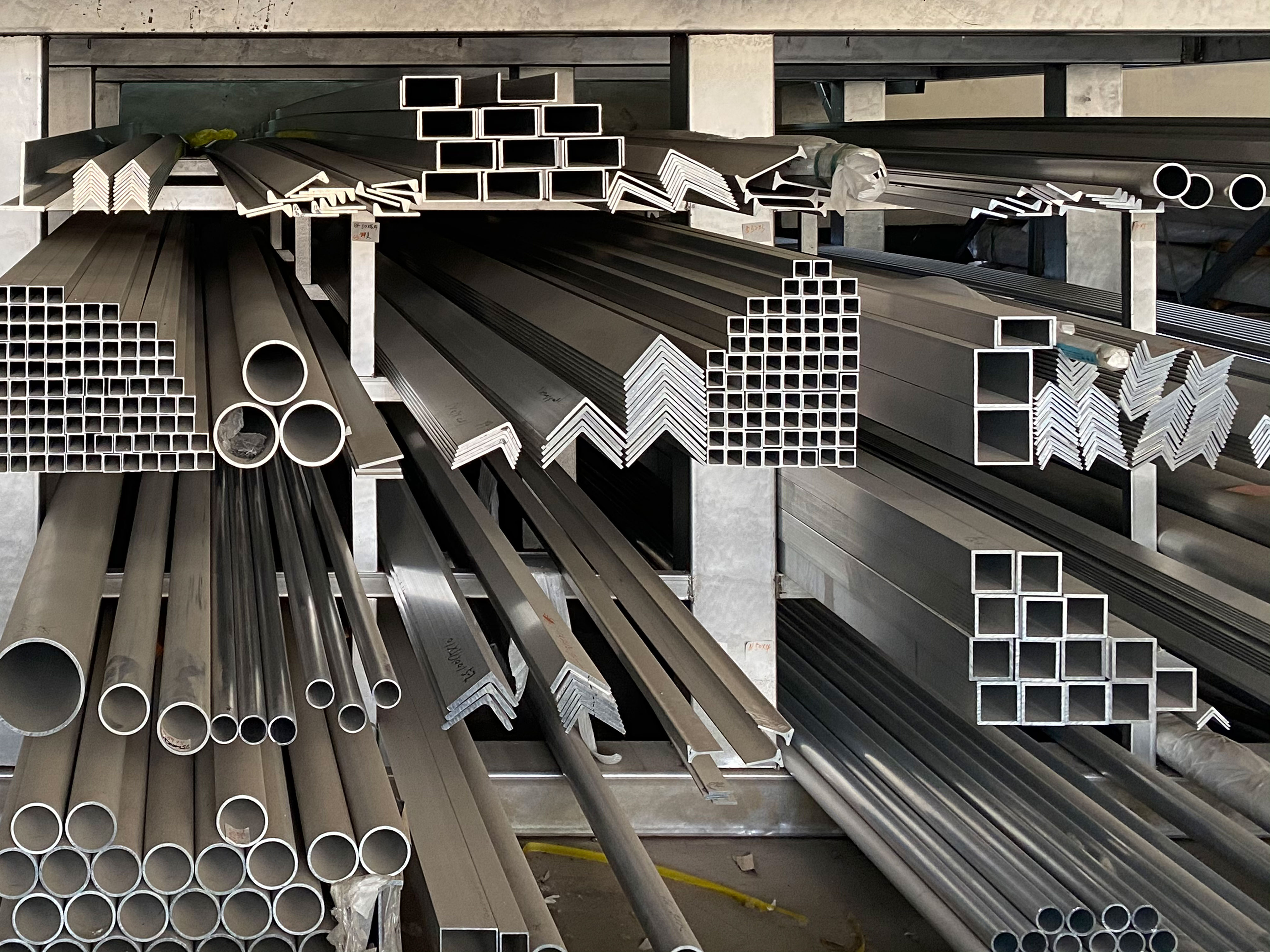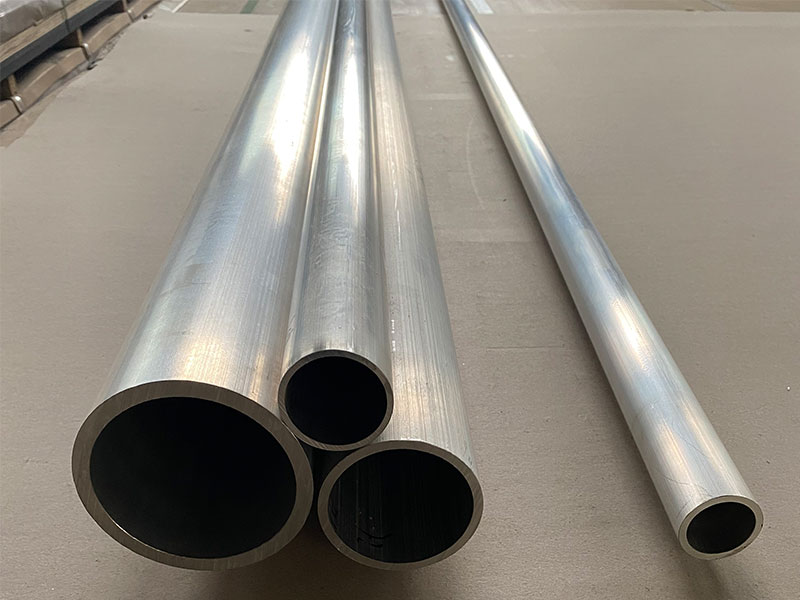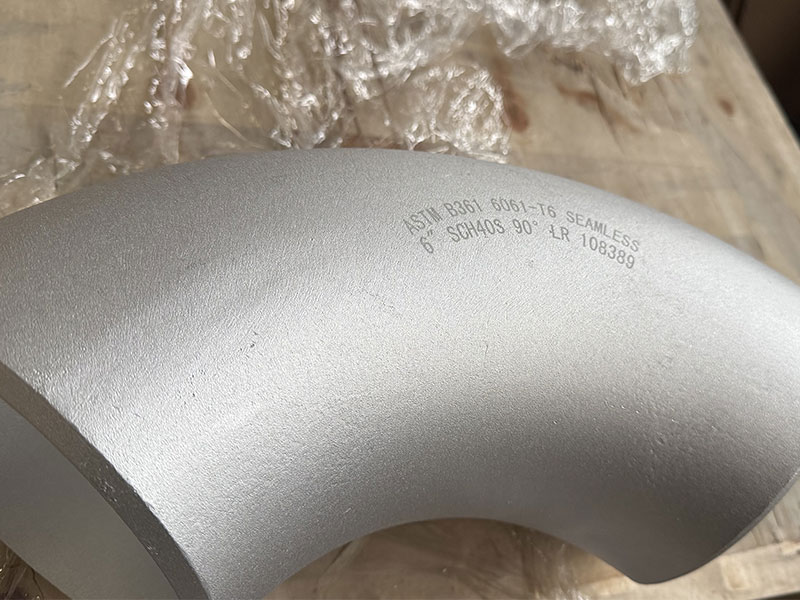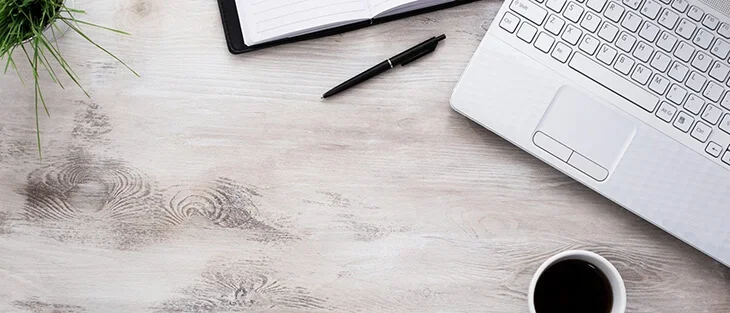Aluminum Pipe Elbow for Saltwater Marine Piping
Aluminum pipe elbows are essential fittings in saltwater marine piping systems. Designed to change the direction of flow, they combine lightweight construction, corrosion resistance, and mechanical strength — characteristics highly valued in marine environments.
An aluminum pipe elbow is a curved fitting used to join two sections of pipe at a specified angle (commonly 45° or 90°). In saltwater marine piping, these elbows are typically fabricated from marine-grade aluminum alloys that resist corrosion from seawater while providing adequate strength for pressure and mechanical loads.
benefits:
- Excellent corrosion resistance in marine environments
- Lightweight — reduces vessel weight and improves fuel efficiency
- Good thermal and electrical conductivity
- Ease of fabrication, welding, and machining
- Recyclable and sustainable material choice
Primary Functions
- Change direction of fluid flow (e.g., 45°, 90°, 180° returns)
- Connect pipes of identical or differing diameters (reducers can be integrated)
- Compensate for misalignment in piping runs
- Enable compact routing in engine rooms, ballast systems, bilge, and fresh water lines
- Provide secure joints that can be welded, brazed, or mechanically joined
Typical Marine Applications
- Seawater cooling circuits (heat exchangers, condensers)
- Raw water intake and discharge lines
- Ballast and trim systems
- Fire main piping and fire-fighting systems
- Bilge and greywater systems
- Deck wash and sea chest connections
- Hydraulic low-pressure service (where aluminum is acceptable)
- Ventilation and ducting in non-pressure applications (when alloy thickness is suitable)
Common Alloy Choices and Why They Matter
Marine service requires alloys that resist pitting, crevice corrosion, and stress-corrosion cracking in chloride-rich environments. Common marine aluminum alloys used for pipe elbows include 5083, 5086, 6061, and 6063. Selection depends on required strength, weldability, and corrosion resistance.
Table: Typical Alloys Used for Marine Aluminum Pipe Elbows
| Alloy | Typical Temper | Marine Corrosion Resistance | Weldability | Typical Use |
|---|---|---|---|---|
| 5083 | H111 / H116 (or O for some components) | Excellent (high Mg) | Excellent | Seawater piping, hull structures |
| 5086 | H116 / H32 | Excellent | Excellent | Seawater service, structural parts |
| 6061 | T6 / T651 | Good (less than 5xxx alloys) | Good (requires post-weld treatment) | Structural tubing, non-critical piping |
| 6063 | T6 / T5 | Moderate | Excellent | Extruded profiles, non-critical piping |
Technical Specifications
Table: Typical Technical Specifications for Aluminum Pipe Elbows (Representative Values)
| Parameter | Typical Range / Value | Notes |
|---|---|---|
| Standard elbow angles | 45°, 90°, 180° | Custom angles available |
| Nominal pipe sizes | 1/2" — 24" (DN15 — DN600) | Larger sizes fabricated on request |
| Wall thickness | Schedule 5S — XXH (or 1.2 mm — 25 mm) | Depends on pressure and code |
| Working pressure | 0.5 — 25 bar (7 — 360 psi) | Depends on wall thickness, alloy, welding quality |
| Design temperature | -196°C to +150°C (varies by alloy) | Check temper limits for high temp |
| Typical joining methods | Welded (GTAW/TIG, MIG), Flanged, Compression fittings | Welding common for permanent joints |
| Surface finish | Mill finish, anodized, painted, epoxy/urethane coatings | Coatings recommended for aggressive environments |
| Corrosion protection | Cathodic protection, coatings, sacrificial anodes | Often combined in seawater service |
Detailed Chemical Composition
Below are representative chemical compositions (wt.%) for alloys commonly used in marine pipe elbows. Actual composition depends on supplier and material certification.
Table: Chemical Composition (wt.%)
| Element | 5083 (approx.) | 5086 (approx.) | 6061 (approx.) | 6063 (approx.) |
|---|---|---|---|---|
| Aluminum (Al) | Balance | Balance | Balance | Balance |
| Magnesium (Mg) | 4.0 — 4.9 | 4.0 — 4.9 | 0.8 — 1.2 | 0.45 — 0.9 |
| Manganese (Mn) | 0.4 — 1.0 | 0.45 — 1.0 | 0.15 — 0.4 | 0.02 — 0.2 |
| Chromium (Cr) | 0.05 — 0.25 | 0.05 — 0.25 | 0.04 — 0.35 | ≤0.1 |
| Iron (Fe) | ≤0.4 | ≤0.4 | ≤0.7 | ≤0.35 |
| Copper (Cu) | ≤0.1 | ≤0.1 | 0.15 — 0.4 | ≤0.1 |
| Silicon (Si) | ≤0.4 | ≤0.4 | 0.4 — 0.8 | 0.2 — 0.6 |
| Zinc (Zn) | ≤0.25 | ≤0.25 | ≤0.25 | ≤0.2 |
| Titanium (Ti) | ≤0.15 | ≤0.15 | ≤0.15 | ≤0.1 |
| Others (each) | ≤0.05 | ≤0.05 | ≤0.05 | ≤0.05 |
| Others (total) | ≤0.15 | ≤0.15 | ≤0.15 | ≤0.15 |
Notes:
- 5xxx series (5083/5086) contain high Mg for corrosion resistance.
- 6xxx series (6061/6063) are heat-treatable alloys with silicon and magnesium.
Mechanical Properties and Tempering Conditions
Mechanical properties depend on alloy and temper. Below are typical values.
Table: Mechanical Properties (Representative)
| Alloy-Temper | Tensile Strength (MPa) | Yield Strength (MPa) | Elongation (%) | Hardness (HB) |
|---|---|---|---|---|
| 5083-H116 | 275 — 350 | 125 — 215 | 12 — 18 | 60 — 90 |
| 5086-H116 | 275 — 340 | 140 — 220 | 12 — 18 | 60 — 90 |
| 6061-T6 | 310 — 350 | 240 — 290 | 8 — 12 | 95 — 120 |
| 6063-T6 | 160 — 220 | 110 — 170 | 8 — 12 | 60 — 95 |
Notes:
- H116/H111/H32 are non-heat-treatable tempers common for marine alloys that emphasize corrosion resistance and weldability.
- T6 is a heat-treated temper providing higher strength; may be less corrosion-resistant than 5xxx alloys and can be susceptible to stress corrosion cracking in chloride environments unless properly processed.
Implementation Standards and Codes
Manufacture and installation of aluminum pipe elbows for marine use often reference these standards and classification society requirements:
Table: Relevant Standards & Codes
| Standard / Code | Scope |
|---|---|
| ASTM B241 / B241M | Aluminum and Aluminum-Alloy Seamless Pipe |
| ASTM B429 | Aluminum-Alloy Extruded Bars, Rods, Wire, Profiles, and Tubes for General Application (can apply to fittings when extruded) |
| ASTM B241M | Metric equivalent for seamless aluminum pipe |
| ASME B31.1 / B31.3 | Power and process piping (consult for pressure design) |
| DNV / ABS / Lloyd's Register | Classification society requirements for marine piping systems |
| ISO 6361 | Wrought Aluminum and Aluminum Alloy Sheets, Strips and Plates (related for welded fabrication) |
| EN 573 / EN 755 | European alloy and extrusion standards |
| AWS D1.2 | Welding of Aluminum (structural welding) |
Notes:
- Shipyards and OEMs typically follow classification society rules (DNV, ABS, LR) that incorporate material testing, NDT, and traceability.
- Welding procedures usually need qualification per ASME or AWS standards.
Fabrication and Joining Methods
- Welding: GTAW (TIG) is common for high-quality joints; MIG (GMAW) suitable for faster production. Suitable filler metals (e.g., ER5356 for 5xxx alloys, ER4043/ER5356 for 6xxx) must be chosen to balance strength and corrosion resistance.
- Hot forming: Bends can be fabricated by mandrel bending or press-brake with subsequent heat treatment where needed.
- Extrusion & machining: Elbows can be cast, fabricated from extruded sections, or mandrel-bent pipe sections; choice depends on size, tolerance, and cost.
- Surface treatments: Anodizing is limited in chlorides; recommended coatings include epoxy primers and marine-grade topcoats. Cathodic protection (sacrificial anodes) is often used for large seawater systems.
Table: Typical Welding Filler Selections
| Base Alloy | Recommended Filler | Notes |
|---|---|---|
| 5083 / 5086 | ER5183 (Al-Mg-3) / ER5356 | ER5183 preferred for higher Mg alloys; minimizes hot cracking |
| 6061 | ER4043 (Al-Si) or ER5356 | ER5356 gives higher strength, ER4043 gives better appearance and ductility |
Corrosion Behavior and Protection
- Pitting and crevice corrosion are primary concerns in seawater. 5xxx alloys (Mg-containing) show excellent resistance; still, crevices, deposits, and galvanic couples can initiate corrosion.
- Avoid direct contact with dissimilar metals (e.g., copper alloys) unless insulated to prevent galvanic corrosion.
- Use protective coatings, regular flushing, and sacrificial anodes where applicable.
- Design for accessibility to inspect and replace sacrificial parts.
Table: Corrosion Management Strategies
| Problem | Mitigation |
|---|---|
| Pitting/Crevice corrosion | Use 5083/5086; avoid crevice-forming assemblies; apply coatings |
| Galvanic corrosion | Electrically isolate dissimilar metals; use compatible fasteners |
| Biofouling | Anti-fouling coatings; periodic cleaning |
| Erosion-corrosion | Increase wall thickness; smooth flow transitions; avoid cavitation |
Quality Control, Testing, and Certification
- Material traceability: Mill test certificates (MTC) showing chemical and mechanical test results
- Non-destructive testing (NDT): Radiography or ultrasonic inspection of welds; dye penetrant for surface defects
- Pressure testing: Hydrostatic or pneumatic testing per design code
- Dimensional inspection: Ensure radius, angles, and end preparations meet specifications
- Surface inspection: Ensure coatings and finishes meet marine exposure requirements
Table: Typical Tests and Acceptance Criteria
| Test | Purpose | Typical Acceptance |
|---|---|---|
| Chemical analysis | Verify alloy composition | Within spec limits (e.g., ASTM) |
| Tensile test | Verify mechanical strength | Meets alloy-temper values |
| Radiographic weld test | Detect internal weld defects | No relevant discontinuities per code |
| Hydrostatic test | Verify pressure integrity | No leakage at test pressure (1.5 x design pressure often) |
| Visual & dimensional | Fit and finish | Within tolerances specified |
Design Considerations for Saltwater Service
- Select alloy and temper for corrosion resistance first; strength second — 5xxx alloys are often preferred.
- Wall thickness must account for corrosion allowance, erosion, and mechanical loads.
- Include sacrificial anodes or cathodic protection for long runs in seawater.
- Minimize crevices and dead legs where stagnant seawater can concentrate chlorides.
- Specify compatible fasteners and supports; stainless steels (316/316L) may still cause galvanic issues if not isolated.
- Consider thermal expansion and vibration: allow for flexible couplings or expansion loops where necessary.
Example Technical Data Sheet (Representative)
Table: Example Elbow Specification (90° Welded Elbow, 5083-H116)
| Item | Specification |
|---|---|
| Material | Aluminum Alloy 5083, Temper H116 |
| End Connections | Butt-weld ends (prepared per ASME/ASTM) |
| OD / ID | Per nominal pipe size (e.g., 4" OD, 3.5" ID) |
| Wall thickness | 5.0 mm (example) |
| Radius | 1.5D (long radius) |
| Design pressure | 10 bar (example) |
| Test pressure | 15 bar hydrostatic |
| Surface finish | Mill finish + epoxy primer + polyurethane topcoat |
| Certification | MTC per EN 10204 3.1 / ASTM MTC; NDT weld radiography; pressure test record |
Installation and Maintenance Tips
- Store fittings in a dry, ventilated area to prevent contamination.
- Clean piping internally before placing into service to remove machining oils and debris.
- Apply appropriate protective coatings prior to installation when possible.
- Use compatible gaskets and isolation materials at flanged joints.
- Schedule periodic inspections for anodic protection, coatings, and signs of corrosion, particularly at welds and joints.
- Replace sacrificial anodes regularly based on consumption rates.
Related Products
Marine aluminum rectangular tubes
Marine Grade Aluminum Rectangular Tubes are made from high-performance alloys such as 5083, 5052, 6061, and 6082. These alloys are renowned for their ability to resist corrosive seawater and marine atmospheres while providing excellent mechanical strength and toughness.
View DetailsCustom marine aluminum profile tubes
Custom Marine Grade Aluminum Profile Tubes are manufactured from premium marine aluminum alloys such as 5083, 5052, 6061, and 6082.
View DetailsMarine aluminum round tubes
Marine Grade Aluminum Round Tubes are manufactured from premium marine alloys such as 5083, 5052, 6061, and 6082, all selected for their proven resistance to seawater corrosion and marine atmosphere degradation.
View Details6061-T6 90-Degree Marine Aluminum Pipe Elbow
Manufactured from premium 6061-T6 marine-grade aluminum alloy, this elbow fitting is engineered to provide reliable and efficient pipe direction changes within shipbuilding, offshore platforms, and marine infrastructure systems.
View DetailsMarine aluminum square tubes
Marine Grade Aluminum Square Tubes are typically constructed from marine-grade alloys such as 5083, 5052, 6061, and 6082—well-known for their ability to withstand the aggressive effects of saltwater and marine atmospheres.
View DetailsRelated Blog
Aluminum Marine Elbow for Ventilation Systems in Offshore Platforms
Offshore platforms operate under demanding environments where every component must align with strict safety, durability, and performance standards.
View DetailsMarine Aluminum Elbow Pipe Fittings for Offshore Oil Rigs
Marine Aluminum Elbow Pipe Fittings for Offshore Oil Rigs: Functions, Applications, and Technical Deep DiveIn the maritime industry, especially concerning offshore oil rigs, the importance of marine-grade materials cannot be overstressed.
View Details5052 Marine Aluminum Round Tubes for Marine Applications
5052 Marine Aluminum Round Tubes are widely acclaimed within the marine industry for their excellent corrosion resistance, strength, and outstanding durability in harsh saltwater environments.
View DetailsAluminum Elbow for Gas and Liquid Transfer on Marine Vessels
Marine vessels operate amidst some of the most challenging environments, where efficiency, durability, and safety of components in fluid transfer systems are paramount.
View DetailsMarine Aluminum Pipe Elbow for Emergency Fire Suppression Lines
In the domain of marine safety systems, reliability and durability are paramount. Among the essential components in fire suppression systems onboard ships and offshore platforms is the Marine Aluminum Pipe Elbow used in emergency fire suppression lines.
View DetailsMarine Aluminum Pipe Elbow for Waste Heat Exhaust Systems
In the demanding environment of marine engineering, selecting the right components for waste heat exhaust systems is decisive for both efficiency and durability.
View Details












Leave a Message